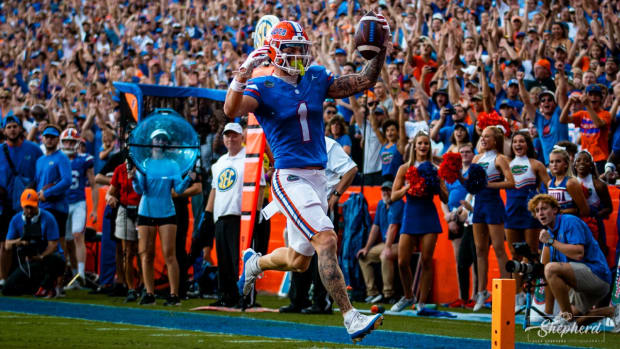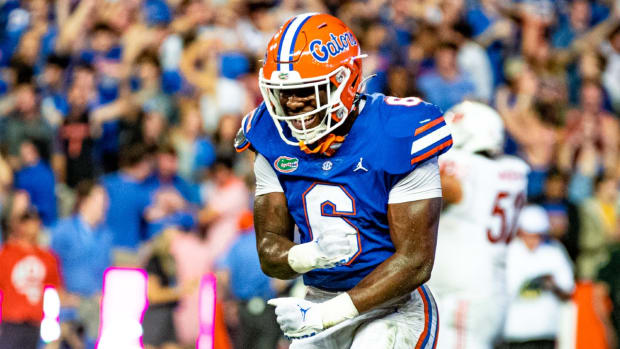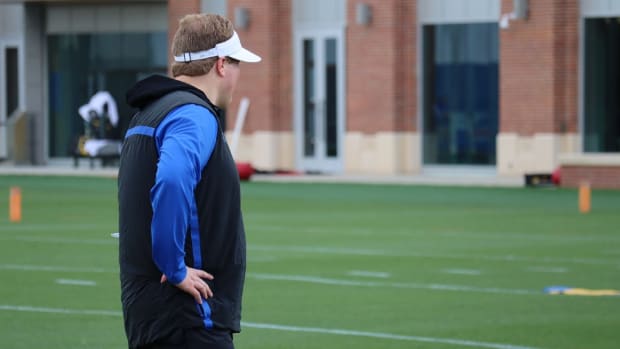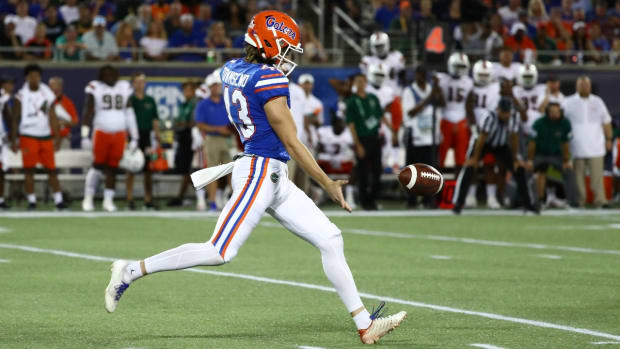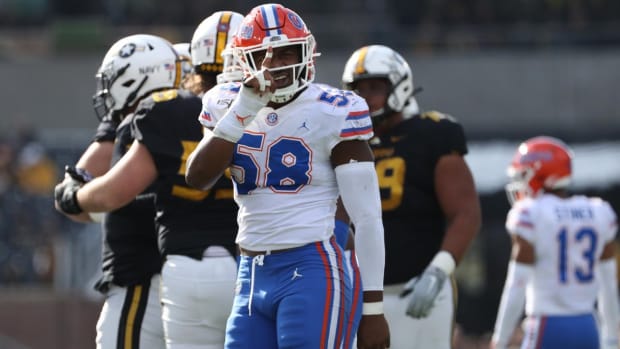Gators FILM ROOM: Trevon Grimes has developed into a complete receiver
Being able to consistently produce in Florida's wide receiver corps is a tough task. With at least six players that could start across the nation, and perhaps more given coach Billy Gonzales' ability to develop at the position, the ball is always spread around.
That philosophy holds true in 2019, as eight receivers have posted receptions through four games, as well as four running backs and a tight end.
Yet, while he ranks tied for third among Gators pass-catchers with only 10 receptions, Trevon Grimes has had the most impressive year of the bunch from that development perspective.
The junior receiver attributes his growth into a more complete receiver to Gonzales, as he told GatorMaven following Saturday's victory over Tennessee. "He [Gonzales] has just been on me about little things," Grimes stated. "About sitting low in my breaks and stuff like that. And I feel like it really translates to the field on game day."
Grimes has lived up to the deep-threat label that fans and analysts alike have tagged him with, averaging 17.6 yards per catch this season. That average is second only to Kadarius Toney, who currently averages 24 YPC - and in fairness, Toney posted 66 of his 72 receiving yards on one of his three receptions, taking a screen pass to the house on the first drive of the year against Miami.
Toney hasn't had much of a chance to come back to Earth either, as he has been sidelined with a shoulder injury since the first quarter of Week 2.
However, Grimes has not only flashed as a deep threat, but as a more complete receiver compared to a year ago. His route running has drastically improved, with cleaner movement skills, awareness, and better timing through his breaks to create separation.
I've clipped up all 10 of Grimes' receptions through four games to break down what he does well. Let's grind that tape.
FILM ROOM
The first clip posted actually isn't a reception by Grimes, but it displays his nuance. This play was really picked apart following Florida's sloppy victory over Miami, for the fumble through the RPO - but quarterback Feleipe Franks confirmed he was attempting to pull the ball because of how open Grimes got on his slant from the outside-slot.
Grimes timed his break perfectly here, in order to let the RPO develop (should Franks and running back Lamical Perine had not fumbled), and by setting up a coverage screen. He utilized the safety coming down to defend Freddie Swain on a bubble screen, and broke into his slant the second the safety stepped into the slot cornerback's peripheral vision. That forced a natural pick to keep the defender's cushion at about three yards, and left him way outside of contesting any pass. Grimes scores with ease if this ball isn't fumbled.
Onto his receptions, we start on a play where Grimes is the secondary read and is mainly responsible for opening up the corner route by tight end Kyle Pitts on a crucial 4th-down conversion attempt in the third quarter. Not only does Grimes do that by pulling both the outside cornerback slightly inside and keeping the coverage linebacker from dropping deep, but he separates well himself on a whip route, also known as a "pig-tail".
This route is typically run by your short, speedy, and nimble slot receiver who can drop and turn his hips on a dime, but Grimes pulls it off very well despite his immense length at 6-5, 214 lbs. While he wasn't the intended target pre-snap, Grimes went above and beyond his responsibility on the play to convert on fourth down himself.
Albeit a simple screen play with a blocker stacked ahead of him, Grimes keeps his feet underneath him with very little wasted movement in order to efficiently get his eyes back to the quarterback after he takes a step forward on the vertical stem. He battles through contact to convert yet another first down.
Oh, and another statistic worth noting: Grimes has converted a first down on nine of his 10 receptions this year (per Pro Football Focus). That's a pretty crazy stat and a testament to Grimes' clutch-factor ability and effectiveness.
We move onto the UT-Martin game, right near the end of the first half. Not much stands out here as Florida clearly had a favorable matchup at the top of the screen, with one cornerback and a deep safety in charge of three receivers.
Going into halftime with a 17-0 lead, it did not require much effort for Grimes, or any receiver in the three-wide set, to get open. He does that by striding into a short vertical zone, and gets the first down to lead the Gators into the locker room.
Without a full-field angle, I'm led to believe - but can't confirm - that Van Jefferson was the primary read on the double play-action by running a deep crossing route. The fake handoff and reverse were meant to draw defenders into the box in order to open the middle of the field for Jefferson.
But with pressure coming off of a delayed six-man blitz, Franks is forced to scramble and look for check-downs. Grimes had no intended route on the play on the fake reverse but adjusted from being a decoy to a short-field target as Franks scrambled his way.
Grimes once again takes advantage of coverage screens in order to separate from his man-coverage cornerback. He releases inside to gain a step on his defender, with a powerful first step off the line to initiate an early advantage in his route. He then waits to cut into his dig route until the Cover 2 safety over the top interferes with the cornerback's lane.
Once that happens, Grimes swiftly works his way into the middle of the field, comfortably separated and able to create yards after the catch.
The casual observer might express concern that Grimes doesn't always accelerate out of ever break, but a lot of that has to do with establishing all route combinations from a multiple-WR set. That happens above as Grimes runs a skinny slant - he allows Josh Hammond from the furthest-inside slot to wash the linebacker out to the flats by himself, the second inside slot to get into his fade and keep the safety deep, and the outside receiver to pull the cornerback to the outside on a curl.
From there, Grimes anticipates an open zone and he finally breaks to the middle of the field. Wide-open. While the play is well-schemed by taking advantage of spacing, Grimes' anticipation is key in order for him to get the ball in that space.
This play provides evidence of the growth Grimes has made as a route runner compared to his sophomore season. At first, Grimes forces a strong outside foot plant by the corner in order to prepare for any inside release, which Grimes quickly adjusts to and gets outside and vertical. At the top of his route, 12 yards down the field on a curl, Grimes does a great job of eliminating wasted steps to sink his hips and turn around swiftly.
From that, the cornerback continues downfield and Grimes ends up with a cushion of six yards at the catch point. That type of separation is almost unheard of on a curl route, especially when it's run by a big-bodied receiver.
Last season, Grimes would typically break down too early to make this turn, with far too many steps through the break which would allow cornerbacks to anticipate the route and come back to play the ball. His length obviously made up for that less than ideal technique, allowing him to contest the ball regardless. But now with far more polished footwork, Grimes doesn't have to rely on his physical intangibles to make plays anymore.
It's hard to determine much about Grimes' route here as he exits the camera view early, but he once again gets himself open to help Franks create something out of nothing on a scramble. And that juke move after the catch to create yards after the reception is yet another example of Grimes' agility taking the next step.
Here's Grimes' early catch against Tennessee, one that went for 43 yards and where he served as the tertiary read. Grimes accelerates the moment each defensive back bites down on the routes from both slot receivers, showing off his impressive 4.47 speed for a player of his size to stretch the field. The ball is underthrown by Kyle Trask, but no matter - Grimes tracks it well and comes back to haul the ball in.
It's really impressive to see how smoothly Grimes operates in his angled route breaks compared to a year ago. While he uses long strides to cover ground, he's matured his footwork to switch gears and utilize short steps with his feet underneath him to break into routes. That development leads to him getting open on slants, digs, out-routes, the whip route seen earlier, and so on - routes in which he didn't separate as well on last season.
The development that Trevon Grimes has made into becoming a well-rounded, complete receiver has been a huge factor into his success. He can now be utilized as more than just a deep threat or someone that the quarterback can throw a pass to on the sidelines and expect him to come down with because he's lengthy and physical.
Now, Grimes runs much cleaner routes than he had in the past, and has really shown growth in the mental side of the game in Florida's nuanced passing offense. He's been super impressive to start the year and will continue to shine, regardless of the target share amongst Florida's offense.

